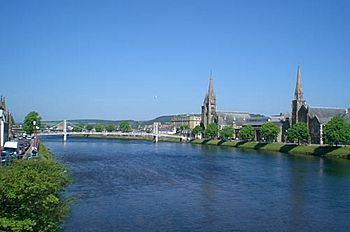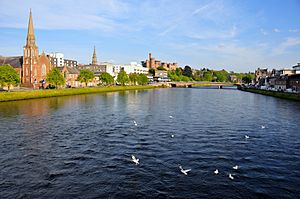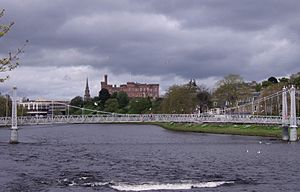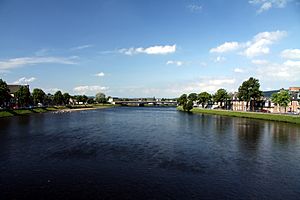River Ness facts for kids
Quick facts for kids River Ness |
|
|---|---|

River Ness looking downstream towards the Greig St Bridge
|
|
| Physical characteristics | |
| Main source | Loch Ness 52.49 ft (16.00 m) |
| River mouth | Beauly Firth 0 ft (0 m) |
| Length | 6.2 mi (10.0 km) |
| Basin features | |
| Basin size | 1,850 km2 (710 sq mi) |
The River Ness is a short but powerful river in Scotland. It flows for about 10 kilometers (6 miles) from the northern end of Loch Ness. The river then travels north-east through Loch Dochfour before reaching the city of Inverness. Finally, it empties into the Beauly Firth.
The name of the city Inverness comes from the River Ness. In Scottish Gaelic, "Inbhir Nis" means "Mouth of the Ness." This shows how important the river has always been to the area.

Contents
What Does "Ness" Mean?
The name Ness comes from an old language called Pictish. It might have come from *Nessa, which was the name of a river goddess. This old name is linked to ancient words for "water."
Where Does the River Flow?
The River Ness officially starts at a small dam called Dochgarroch weir. This is at the end of Loch Dochfour. The river then flows into the eastern part of the Beauly Firth. The Beauly Firth is connected to the larger Moray Firth.
Even though the River Ness is short, it carries a lot of water. It has one of the highest average water flows in the UK. This is because it collects water from a very large area. Part of the Caledonian Canal also uses the River Ness.
Ness River System
The River Ness gets its water from Loch Ness. This means that all the rivers flowing into Loch Ness are part of the River Ness system. This whole area is called the Ness catchment area.
Some of the rivers that feed into Loch Ness include:
- River Farigaig
- River Enrick
- River Coiltie
- River Foyers
- River Moriston
- River Oich (which connects Loch Oich to Loch Ness)
This river system follows a long, natural crack in the Earth called the Great Glen Fault.
Famous Buildings by the River
Many important buildings stand along the River Ness in Inverness.
Inverness Castle sits on a hill overlooking the river. Next to the castle, you can find the Inverness Museum and Art Gallery. The Eden Court Theatre, one of Scotland's biggest theaters, also looks out over the river.
Inverness Cathedral is right on the riverbanks. So is Old High St Stephen's church, which is on a hill called St Michael's Mount. Many hotels for tourists are also built along the river.
Bridges Over the Ness
Several bridges cross the River Ness in Inverness. These bridges help people get around the city.
Some of the bridges include:
- The Ness Islands bridges, which connect small islands in the river.
- The Infirmary Bridge, built in 1879.
- Ness Bridge, built in 1961. It replaced older bridges that had been damaged by floods.
- The Greig Street Bridge, a beautiful suspension bridge built in 1881.
- Friar's Bridge.
- Waterloo Bridge.
- The Railway Bridge, a steel bridge built in 1989 after an earlier stone bridge was washed away by floods.
- Holm Mills Bridge, part of the Inverness southern bypass, finished in 2017.
Nature and Parks
Upstream from the city center are the Ness Islands. These islands are great for nature walks and have many beautiful trees. You can often see fishermen trying to catch Atlantic salmon in the river.
The Ness District Salmon Fishery Board works to protect and improve the salmon and sea trout in the area.
Many animals can be seen along the river:
- Common seals and grey seals often swim here.
- Birds like grey herons, herring gulls, great black-backed gulls, oystercatchers, mallards, dippers, and goosander are common.
- You might also spot pipistrelle and Daubenton's bats, housemartins, and grey wagtails.
- Sometimes, Arctic terns line the riverbanks.
- Rarely, you might see an eagle owl or an osprey fishing.
- European otters are sometimes seen too.
The riverbanks are also lined with lovely lime trees.
Near the Ness Islands, you'll find Bught Park. This park has sports facilities and places for fun. It includes the Inverness Sports Centre and Aquadome, an ice rink, and the Inverness Botanic Gardens. The Botanic Gardens have tropical and desert glasshouses.
Further upstream is Whin Park, which has a pond where you can go boating.
In Cavell Gardens, near the Infirmary Bridge, is the Inverness war memorial. It honors those who died in the two world wars.
The Port of Inverness
The Port of Inverness is located where the River Ness meets the sea. There is also a modern marina here where private boats and yachts can dock.
Interesting Stories
The first reported sighting of the famous Loch Ness Monster was actually in the River Ness! This happened in AD 565. It is said that Saint Columba made a "water monster" go back into the river after it tried to attack one of his followers.
Another story about Saint Columba and the River Ness tells of a wizard named Broichan. When Columba visited a king named Bridei I, he met Broichan, who had an Irish slave-girl. Broichan refused to free her. Columba then picked up a white pebble from the river. He said the pebble would heal many sick people and that Broichan was suffering for his actions.
Soon after, messengers arrived saying Broichan was very ill. Columba gave them the stone and told them to put it in water for Broichan to drink, but only if he agreed to free the slave-girl. Broichan agreed, drank the water, and was healed! The stone floated on the water. The king kept this special stone, and people would drink water with it to be healed.
See also
In Spanish: Río Ness para niños




